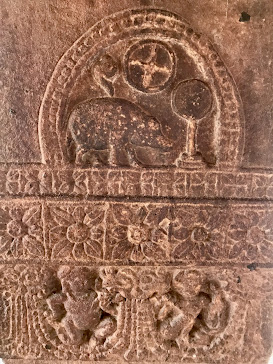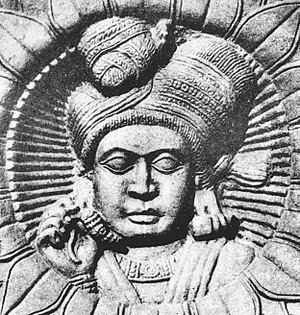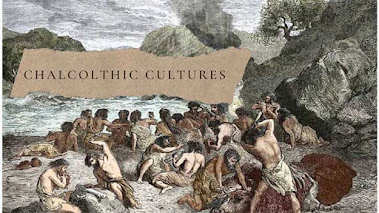Chalukya and Rashtrakruta Dynasties
Chalukya Dynasty
Rise of the Chalukya dynasty
The Chalukya dynasty was a Classical Indian dynasty that ruled large parts of southern and central India between the 6th and the 12th centuries. Pulakeshin I, a chieftain of Pattadakal, took and strengthened the hill fort of Vatapi and seized control of the territory between the Krishna and Tungabhadra rivers and the Western Ghats. His son Kirtivarman I secured the Konkan coast and coastal regions near Vengi. At its peak, the empire stretched from the Kaveri in the south to the Narmada in the north.
The Chalukyas ruled as three closely related but individual dynasties. These are the "Chalukyas of Badami" (called "Early Chalukyas"), the "Chalukyas of Kalyani" (also called Western Chalukyas or "Later Chalukyas") and the "Chalukyas of Vengi" (also called Eastern Chalukyas).
Chalukyas of Badami
In the 6th century, with the decline of the Gupta dynasty, the Deccan and Tamilakam regions began to experience political metamorphoses. The Chalukya dynasty was established by Pulakeshin I in 543. Pulakeshin I took Vatapi under his control and made it his capital. The Chalukyas ruled over an empire that included Karnataka, Andhra Pradesh, and regions up to the northern extents of the Pallava kingdom. The last Chalukya king, Kirtivarman II, was overthrown by the Rashtrakuta King Dantidurga in 753.
Chalukyas of Kalyani
In 973, Tailapa II overthrew Karka II, re-established the Chalukya rule in the western Deccan, and recovered most of the Chalukya empire. This dynasty came to be known as the Western Chalukyas or the Chalukyas of Kalyani. Vikramaditya VI is widely considered the most notable ruler of the dynasty. They ruled for over 200 years and went into their final dissolution towards the end of the 12th century with the rise of the Hoysala Empire, the Pandyas, and Yadavas.
Chalukyas of Vengi
Pulakeshin II conquered the eastern Deccan in 616 and appointed his brother Kubja Vishnuvardhana as Viceroy in 621. After the death of Pulakeshin II, the Vengi Viceroyalty developed into an independent kingdom and included the region between Nellore and Visakhapatnam. After the downfall of the Badami Chalukya empire in the mid-8th century, territorial disputes flared up between the Rashtrakutas and the Eastern Chalukyas. For much of the next two centuries, the Eastern Chalukyas had to accept subordination towards the Rashtrakutas.
Social, economic, and political life under the Chalukyas
The rule of the Chalukyas marks a significant milestone in the history of South India and a golden age in the history of Karnataka. The political atmosphere in South India shifted from smaller kingdoms to large empires with the ascendancy of Badami Chalukyas. A Southern India-based kingdom took control and consolidated the entire region between the Kaveri and the Narmada rivers. The rise of this empire saw the birth of efficient administration, overseas trade and commerce, and the development of the new style of architecture called "Chalukyan architecture". Kannada literature, which had enjoyed royal support in the 9th-century Rashtrakuta court found eager patronage from the Western Chalukyas in the Jain and Veerashaiva traditions. The 11th century saw the patronage of Telugu literature under the Eastern Chalukyas.
The Badami Chalukya era was a momentous period in the development of South Indian architecture. Their style of architecture is called "Chalukyan architecture" or "Karnata Dravida architecture". Many temples such as the Huccimalli Gudi Temple, the Banantigudi Temple, and the Mahakutesvara Temple were also built. The rule of the Western and Eastern Chalukyas is a prominent event in the history of Kannada and Telugu literature respectively. By the 9th–10th centuries, the Kannada language had already seen some of its most notable writers. The "three gems" of Kannada literature, Adikavi Pampa, Sri Ponna, and Ranna belonged to this period. In the 11th century, Telugu literature was born under the patronage of the Eastern Chalukyas with Nannaya Bhatta as its first writer.
Both Shaivism and Vaishnavism flourished during the Badami Chalukya period, though it seems the former was more prevalent. Vedic sacrifices, religious vows, and the giving of gifts were important. The Badami kings were followers of Vedic Hinduism and dedicated temples to popular Hindu deities in Aihole. The kings of the dynasty were however secular and actively encouraged Jainism.
The government, at higher levels, was closely modeled after the Magadhan and Satavahana administrative machinery. The empire was divided into Maharashtrakas (provinces), then into smaller Rashtrakas (Mandala), Vishaya (district), Bhoga (group of 10 villages). At the lower levels of administration, the Kadamba style prevailed fully. In addition to imperial provinces, there were autonomous regions ruled by feudatories such as the Alupas, and the Sendrakas. Local assemblies and guilds looked after local issues. Taxes were levied on loads, retail goods in transit, sales, betel, land and to support royalty.
The Chalukya era may be seen as the beginning of the fusion of cultures of northern and southern India, making way for the transmission of ideas between the two regions. The Chalukyas begot the Vesara style of architecture which includes elements of the northern nagara and southern Dravida styles. During this period, the expanding Sanskritic culture mingled with local Dravidian vernaculars which were already popular. It was during the Western Chalukya rule that the Bhakti movement gained momentum in South India, in the form of Ramanujacharya and Basavanna, later spreading into northern India.
Rashtrakruta Dynasty
Rise of the Rashtrakuta dynasty
Rashtrakuta was a monarchical Indian dynasty ruling large parts of the Indian subcontinent between the 6th and 10th centuries. The Elichpur clan was a feudatory of the Badami Chalukyas. During the rule of Dantidurga, it overthrew Kirtivarman II and went on to build an empire with the Gulbarga region as its base. This lineage came to be known as the Rashtrakutas of Manyakheta, rising to power in South India in 753 AD. At their peak, the Rashtrakutas of Manyakheta ruled an extensive empire stretching from the Ganges River and Yamuna River doab in the north to Kanyakumari in the south.
Social Political and economic life
The king had several ministers in his court- Chief Minister, commander (Dandanayaka), the foreign minister (Mahakshapataladhikrita), and a prime minister (Mahamatya). The kingdom was divided into Mandalas or Rashtras (provinces). Under a Rashtra was a Vishaya (district) overseen by a Vishayapathi. Below the Vishaya was the Nadu, looked after by the Nadugowda. The lowest division was a Grama or village administered by a Gramapathi.
The Rashtrakuta economy was sustained by its natural and agricultural produce, manufacturing revenues, and the money gained from its conquests. Cotton, rice, and woods such as sandal and ebony were exported. The Deccan was also rich in minerals such as copper and diamonds. The empire controlled most of the western coastal region of the subcontinent, which facilitated its maritime trade. The government's income came from taxes and tributes from feudatories.
The Rashtrakuta rule was tolerant to multiple religions- Jainism, Vaishnavism, and Shaivism. Buddhism also found support and was popular in places, although it had declined significantly by this time. By the 9th century, kings from all the four castes had occupied the highest seat in the monarchical system in Hindu India. Women and daughters had rights over property and land.
Kailash Temple Cave no. 16
Kannada became more prominent as a literary language during the Rashtrakuta rule - with its script and literature showing remarkable growth, dignity, and productivity. This period effectively marked the end of the classical Prakrit and Sanskrit eras. Writers such as Asaga, Mahaviracharya, Durvinita, and Adikavi Pampa wrote prominent works of literature during this era. The Rashtrakuta contributions to art and architecture are reflected in the splendid rock-cut cave temples at Ellora and Elephanta. The Kailasanath Temple, the Virupaksha temple, and numerous temples at Shirival were commissioned by them.During their political expansion into central and northern India, the Rashtrakutas or their relatives created several kingdoms that either ruled during the reign of the parent empire or continued to rule for centuries after its fall. In conclusion, the rise of the Rashtrakutas of Manyakheta had a remarkable impact on Indian history, economy, and art. Some historians have called these times an "Age of Imperial Kannauj" or "Age of Imperial Karnataka".
Fall of the Rashtrakutas
In 972 A.D., during the rule of Khottiga Amoghavarsha, King Siyaka Harsha attacked the empire. This undermined the reputation of the Rashtrakuta Empire and consequently led to its downfall. The final decline was sudden as Tailapa II, a feudatory of the Rashtrakuta ruling, declared himself independent by taking advantage of this defeat. The Western Chalukyas annexed Manyakheta and made it their capital.
Image References:-
NOTE :-
This blog is meant for Educational Purpose only .We do not own any Copyrights related to images and information , all the rights goes to their respective owners . The sole purpose of this blog is to Educate, Inspire, Empower and to create awareness in the viewers. The usage is non-commercial(Not For Profit) and we do not make any money from it.








Comments
Post a Comment